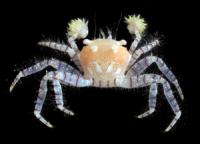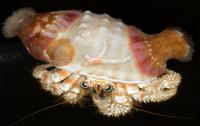
This crab was collected during a three-week expedition to the Northwestern Hawaiian Island National Monument. Joel Martin, NHMLAC, NOAA A three-week scientific expedition to French Frigate Shoals in the Northwestern Hawaiian Islands Marine National Monument returned to Honolulu on Sunday with the discovery of many new species and a better understanding of marine biodiversity in the Hawaiian Archipelago.
An all-star team of world-renowned taxonomists (biologists specializing in identifying and naming organisms) and an experienced support crew collected and photographed many species that they cannot identify and are thought to be new species to science. The expedition found several potentially new species of crabs, corals, sea cucumbers, sea quirts, worms, sea stars, snails, and clams. Many other species were found that are known from other areas but have never been recorded from French Frigate Shoals, the Northwestern Hawaiian Islands, or even the Hawaiian Archipelago. From this expedition, well over a hundred new species records will likely be identified for French Frigate Shoals.
Scientists aboard the National Oceanic and Atmospheric Administration Ship Oscar Elton Sette conducted biodiversity surveys at French Frigate Shoals, with a focus on the small marine organisms - crabs, worms, and many other invertebrates, algae, and even microbes - which are often overlooked but that make up the majority of living diversity on coral reefs. "It was a very successful expedition by almost any criterion, and the discovery phase has really only just begun. In the coming months, and even over the next several years, we will be conducting morphological examinations and analyzing genetic sequence data in order to further identify and classify these organisms, and possibly to shed some light on where these species originated," said Dr. Joel W. Martin of the Natural History Museum of Los Angeles County. "What we did not find is also important. There were several groups of animals that we expected to find but did not find, or found only rarely, such as porcellanid crabs. The apparent absence of these common reef organisms may provide insight into how the unique flora and fauna of French Frigate Shoals came to be."
Over 50 different sites were surveyed throughout the atoll using a variety of ingenious collection methods including baited traps, brushing of rubble, underwater vacuuming with gentle suction, plankton tows, light traps, sediment and water sampling and many others. These methods were meticulously developed with consultation between scientists, management agencies, and the public over the course of a year, to minimize impact to the environment. "Because our work was conducted within the borders of the world's largest fully protected marine area, we have been extremely careful to follow protocols that would minimize any disturbance to this ecologically delicate region. It's hoped that our work will heighten public appreciation and awareness of this unique area and lead to a better understanding of how we manage such large and sensitive marine areas," said Dr. Martin. In all, more than 200 sampling events were conducted, producing more than 2,500 recorded collections.
The expedition was part of the international Census of Marine Life's Census of Coral Reef Ecosystems or CReefs and was led by NOAA's Pacific Islands Fisheries Science Center, with funding from NOAA's Coral Reef Conservation Program and the Alfred P. Sloan Foundation. This expedition is the first in a series of proposed CReefs surveys led jointly by Scripps Institution of Oceanography at UC San Diego, Australian Institute of Marine Science, and NOAA Pacific Islands Fisheries Science Center's Coral Reef Ecosystem Division to take place around the globe. The broader Census of Marine Life consists of 17 projects intended to assess the diversity, distribution, and abundance of ocean life and explain how it changes over time. Fourteen of these projects focus on different ocean realms, of which the CReefs project focuses on providing baseline information that is currently lacking for coral reef ecosystems around the world.
Chief Scientist Dr. Russell Brainard of NOAA Fisheries Coral Reef Ecosystem Division was very pleased with the results from this Census of Coral Reefs expedition in the Northwestern Hawaiian Islands. "I hope the positive results from this CReefs expedition will demonstrate the usefulness of these types of intensive biodiversity surveys for understanding and conserving the coral reef ecosystems of Hawaii and elsewhere around the globe. A comprehensive understanding of the biodiversity of our marine areas is necessary so that we can be better stewards of our ocean resources through ecosystem approaches to management."
Expedition members not only collected the organisms, but they took hundreds of stunning images that show these organisms in all their spectacular complexity and beauty using an impressive arsenal of photographic equipment. Many of these images can be seen on the expedition websites. In addition to the photographs taken by the scientists, Susan Middleton, who recently co-produced a photographic book for National Geographic on the plants and animals of the Northwestern Hawaiian Islands called "Archipelago: Portraits of Life in the World's Most Remote Island Sanctuary," was onboard and glued to her camera the majority of the time. 
Anemone hermit crab, Dardanus brochypops, with sea anemone, Caliactis armatus, with an unidentifed barnacle on its shell that may be a new species. National Oceanic and Atmospheric Administration
"It is not until you start looking through the macro lens at these organisms, and give them time to get settled, that you start to see the vibrant colors, the fine hairs covering a crab's shell, the flecks of color in the translucent tentacles of an anemone, the incredible evolutionary adaptations for survival," she said. "It is then that I realize how infinitely complex life is on a coral reef, and how grateful I am to these scientists for helping me to see organisms that have spent millions of years evolving colors, shapes, and behaviors in order not to be seen."
Dr. Gustav Paulay, Curator of Invertebrates for the Florida Museum of Natural History and an expert on tropical Pacific coral reef invertebrates, said "the information gained from this expedition will help us to understand the evolution of life in the Northwestern Hawaiian Islands, and provide a biogeographic baseline to study the pathways by which marine organisms have spread throughout the archipelago."
Dr. Jim Maragos, a coral expert with the U.S. Fish and Wildlife Service's Pacific Remote Islands National Wildlife Refuge Complex who has worked in the Northwestern Hawaiian Islands for over 6 years and participated in many research expeditions to the area, as well as spent a long career spanning the tropical Pacific, was astounded when another expedition member, John Starmer, showed him a species he has never seen. "There was this tiny coral colony that John showed to me off the eastern side of the atoll that I have no idea what it is," he said. "I cannot even place the genus or family it belongs to. It is a complete unknown." During the cruise Dr. Maragos has discovered as many as 11 new species of coral and 18 new records at French Frigate Shoals, but this one is unique in that he cannot even place it in a category, nor could Dr. Paulay, also a recognized coral expert. Dr. Maragos reported the second sighting of an improbable new species of Acropora coral discovered last month further up the chain at Lisianski.
Managers from the three co-trustee agencies responsible for management of the Northwestern Hawaiian Islands Marine National Monument were also enthusiastic about the results from the expedition, and their application to management of the area. Dr. Dan Polhemus of the State of Hawaii Department of Land and Natural Resources, Division of Aquatic Resources, himself an invertebrate expert, applauded the scientists' efforts, many of whom donated their time to participate in the expedition. Although it will take a year or more before all the data are processed, and species are fully identified or newly described, according to Dr. Polhemus, the State looks forward with great anticipation to the results from this expedition and the benefit this understanding will give to management of the natural marine resources. Source : Census of Marine Life
 Print Article
Print Article Mail to a Friend
Mail to a Friend
